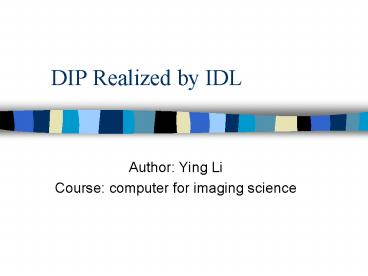DIP Realized by IDL PowerPoint PPT Presentation
Title: DIP Realized by IDL
1
DIP Realized by IDL
- Author Ying Li
- Course computer for imaging science
2
Program Overview
- My project has 5 modules
- 1. Zooming module
- 2. Filter module
- 3. Fourier transform module
- 4. Histogram module
- 5. Motion blur and restoration module
3
Zooming Module Interface
4
Filter module Interface
5
Fourier transform module
6
Histogram module interface
7
Motion blur and restoration
8
Interface Architecture
Menu bar
Selection Base
Display window
Zooming base
9
Zooming module
10
(No Transcript)
11
Zooming Module
- Color table
- Keep track of the button status
- Restrict the rectangle from going outside of the
image - Erase old rectangles
12
Color Table
- I want to display a gray level image with a red
region of interest displayed on it. So I need a
color table of my own.
13
- I set a flag variable to keep track of the mouse
buttons status. So user can only drag the red
rectangle with the mouse button pressed down. - The program calculated carefully to prevent the
red rectangle from going outside of the image.
14
Erase old rectangle
- In order for the red rectangle to go with the
mouse, the program must erase the old rectangle
and draw a new rectangle at the new position. - To do this I use a hidden draw widget to display
the image at exactly the same position, and erase
old rectangle by copy data from the hidden window.
15
Filter Module
- In this module I realized four kind of filters
- Ideal low pass filter
- Ideal high pass filter
- Ideal band pass filter
- Butterworth low pass filter
16
(No Transcript)
17
Ideal low pass filter
18
Ideal high pass filter
19
Butterworth filter
20
Butterworth FilterWe know because of the the
sharp edge of the ideal filters, there will be
some oscillation on the output signal of ideal
filters.
21
This is the output of a STEP function go through
an ideal low pass filter
22
So, we want a kind of filter whose edges go down
slowly. Butterworth filter was introduced.This
is the equation of a 1-D Butterworth filter
- Here N is the order of the Butterworth filter and
?c is the frequency cutoff
23
N2 N6
24
Restore this degraded image
25
Go through a ideal low pass filter
26
Go through a Butterworth filter
27
Fourier Transform Module
28
Histogram module
29
Histogram module
30
Motion Blur Restoration
- Using a Inverse Filter to deconvolve the point
spread function - Using convolve method to get ride of the blur
coursed by the motion of the detector or the
object
31
Inverse FilterBefore image restoration can be
accomplished, the PSF of the blurring
function(that is the system transfer function of
the degrading system) must be known. Actually
most system that course the degrading of images
are linear shift invariant system.
32
Degradation model
33
Solve by inverse filterHere if the noise
is very small and can be neglected. Then we can
restore the image by a reverse filter
34
PSFThe point spread function is a line
here, if the exposure time is small enough.
35
Result of inverse filter method
36
Convolution Method
- We still have some other ways to restore a motion
blurred image.
The motion blur
is coursed by the moving of the detector or the
object within the exposure thim T. That is
37
Convolution methoditerate the procedure we
can get the follow equation
38
Convolution method
- From that we can see that the result is the
convolution of the derivation of the degraded
image with a comb function
39
Result of convolution method
40
Result of convolution method
41
Result of convolution method
42
Result of convolution method
43
Conclusion
- In this project I used such widgets labels,
texts, draws,bases,drop lists, radio buttons,
slider bars, menus, module dialogue form. - I realized such functions Region of interest,
ideal low pass filter, ideal high pass filter,
ideal band pass filter, butterworth filter, with
different parameters, fourier transform, image
histogram, histogram equalization, image blur, a
inverse filter, convolution method to restore
motion blur, a module dialogue form
44
(No Transcript)

